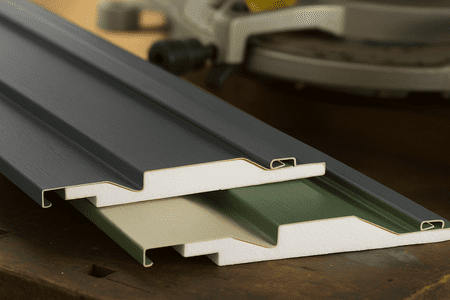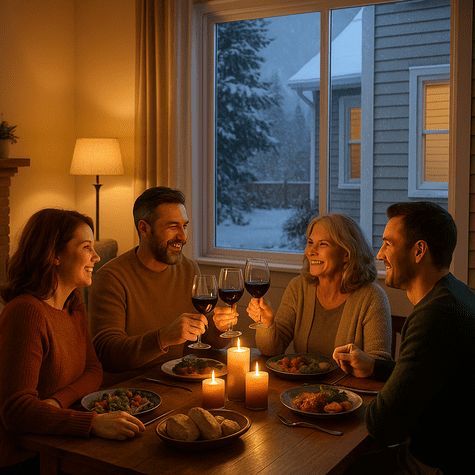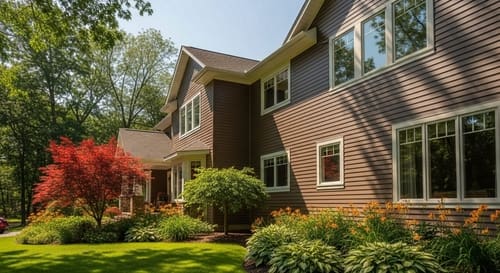How Insulated Vinyl Siding Can Seriously Slash Your McHenry County Energy Bills (And Look Good Doing It!)
Tired of Your Thermostat Playing Tug-of-War with Your Wallet?

Rhett Wilborn here, from Innovative Home Concepts. If you’re a McHenry County homeowner, you know our weather has more mood swings than a teenager on a caffeine bender. One minute it’s “Siberia Chic,” the next it’s “Amazon Rainforest Humid.” And who pays the price? Your trusty HVAC system… and your bank account. If you’ve ever looked at your energy bill and thought it was a typo, or perhaps a ransom note, you’re not alone. Many folks don’t realize that their home’s siding – or lack of *effective* siding – is like wearing a t-shirt in a blizzard. It’s just not cutting it.
But what if I told you there’s a way to give your house a high-tech thermal hug, one that not only keeps you more comfortable year-round but also tells your energy meter to take a chill pill? We’re talking about a serious upgrade that often flies under the radar: insulated vinyl siding. Now, before you picture some bulky, فضائیہ-looking contraption, let me assure you, this stuff is sleek, stylish, and smarter than a whip. Let’s dive in, and I promise to explain it all without needing a degree in thermodynamics.
What in the Walls IS Insulated Vinyl Siding, Anyway?
Alright, let’s demystify this. When you hear “vinyl siding,” you might think of the traditional, hollow-backed panels that have been around for ages. And those are fine, they do a job. But insulated vinyl siding is like the superhero version of its older cousin. Imagine your standard, durable vinyl siding panel. Now, picture a perfectly contoured, rigid foam insulation backing that’s either laminated or permanently fused to that panel. It’s not just some flimsy piece of foam stuffed in there; this is engineered for a precise fit and maximum performance.

Think of it like this: regular vinyl siding is a windbreaker. It blocks the wind, sheds the rain, looks decent. Insulated vinyl siding is that same windbreaker, but with a high-performance thermal fleece lining built right in. It provides not just an outer layer of defense, but also a critical barrier against energy loss. This foam backing is typically made of expanded polystyrene (EPS), a material known for its excellent insulating properties, moisture resistance, and structural stability. It doesn’t just fill the void; it transforms the siding panel into a more robust, energy-saving component of your home’s exterior wall system. This integrated system is what sets it apart and allows it to deliver some pretty impressive benefits, especially when we start talking numbers – R-values, to be specific.
The “Sciencey” Bit: How This Siding Puts the Freeze on Energy Loss (Without Boring You to Tears)
Okay, stay with me here. I know “R-value” and “thermal bridging” sound like terms best left to engineers in lab coats, but understanding them, even basically, is key to seeing why insulated siding is such a smart move. I’ll keep it simple – promise!
R-Value: Your Home’s Official Coziness Score
The “R” in R-value stands for resistance – specifically, resistance to heat flow. The higher the R-value, the better a material is at insulating. Think of it like the tog rating on a duvet or the thickness of a good winter coat. Traditional, non-insulated vinyl siding has a very low R-value on its own (maybe R-0.6, if we’re being generous). The underlying sheathing and cavity insulation in your walls do the heavy lifting.
But insulated vinyl siding comes to the party with its own insulation, typically adding an R-value of R-2 to R-5.5, or even more, depending on the product’s thickness and density. This might not sound like a colossal number compared to, say, R-19 attic insulation, but here’s the kicker: it’s *continuous* insulation on the *outside* of your wall studs. And that leads us to our next villain…
Thermal Bridging: The Sneaky Energy Thief Hiding in Your Walls

Your wall studs (the wooden framework of your house) make up about 25% of your wall area. Wood is a much poorer insulator than actual insulation. So, these studs act like little highways for heat to escape in the winter and sneak in during the summer. This phenomenon is called “thermal bridging.” It’s like having gaps in that otherwise good winter coat. Even if you have insulation *between* the studs, the studs themselves are weak points, undermining the overall R-value of your wall system.
Insulated vinyl siding, by providing that layer of continuous insulation over the studs, effectively blankets these thermal bridges. It’s like throwing an extra quilt *over* the entire bed, covering all the cold spots. This can significantly boost the *actual* R-value performance of your entire wall, not just the parts with cavity insulation. We’re talking about a noticeable difference in how much your furnace or AC has to run.
Air Infiltration: Sealing the Deal (and the Drafts)
Tiny cracks and gaps around windows, doors, and even through the walls themselves can lead to air infiltration – drafts, in plain English. This means your conditioned air (warm in winter, cool in summer) is escaping, and unconditioned outside air is barging in. Insulated siding, with its thicker, more rigid panels and foam backing, can help create a tighter building envelope. The panels often interlock more snugly, and the foam can help seal small imperfections in the wall surface, reducing those pesky drafts and further improving your home’s energy performance. It’s like caulking a leaky window, but on a much grander scale.
McHenry County vs. The Elements: Why Insulated Siding is Your Secret Weapon Here
Let’s bring this home to McHenry County. Our weather isn’t just a conversation starter; it’s a major factor in our home maintenance and energy consumption. Here’s how insulated vinyl siding specifically squares off against our local climate capers.
Battling Winter’s Bite: Less Furnace, More Fuzzy Slippers
When those polar vortex parties roll into town, and the temperature plummets, your heating system goes into overdrive. By reducing heat loss through thermal bridging and adding that extra R-value blanket, insulated siding means more of the heat your furnace produces *stays inside your home*. This translates to a more consistently comfortable house, fewer cold spots near exterior walls, and, most importantly, lower heating bills. You might even find yourself turning down the thermostat a degree or two without sacrificing comfort – and that’s money right back in your pocket, or perhaps into a fund for more fuzzy slippers.
Taming Summer’s Sizzle: A Cooler Home, a Happier Wallet
Come July and August, when the McHenry County humidity makes you feel like you’re swimming through the air, your air conditioner is the MVP. Insulated siding works just as hard in the summer, but in reverse. It helps to block the sun’s radiant heat from penetrating your walls and reduces the amount of heat conducted through the studs. This means your AC doesn’t have to fight as hard to keep your home cool. Again, this leads to a more comfortable indoor environment and savings on your cooling costs. It’s about keeping that expensive cool air where it belongs – inside!
“Wind? What Wind?” – The Unsung Hero of Stability
Let’s not forget the wind. Those blustery days can make a flimsy siding rattle and can drive cold air into any available crevice. Because insulated vinyl siding panels are more rigid due to the foam backing, they tend to resist wind better. They lie flatter against the wall, are less prone to waving or rattling, and contribute to that tighter building envelope we talked about, further reducing drafts. This added solidity is a nice bonus on top of the thermal benefits.
More Than Just a Pretty Face (Though It’s That Too!)
While the energy efficiency aspect is a huge draw, insulated vinyl siding brings a few other welcome party guests to your home improvement project. It’s not a one-trick pony, folks.

Noise Reduction: Your Own Cone of Silence (Almost)
That rigid foam backing doesn’t just block temperature transfer; it also helps to dampen sound. If you live near a busy street, have boisterous neighborhood kids, or just appreciate a quieter indoor environment, you’ll likely notice a reduction in exterior noise transmission with insulated siding. It’s like getting a free upgrade to a more serene home life.
Durability & Impact Resistance: Tougher Than It Looks
Traditional hollow vinyl siding can sometimes be prone to cracking or denting from hail, a stray baseball, or an errant lawnmower pebble. The foam backing on insulated vinyl siding provides significant extra rigidity and support, making it much more resistant to impacts. It can absorb shocks better, reducing the chances of dents, dings, and cracks. This means your siding will look newer for longer and potentially save you from repair hassles.
Curb Appeal That Counts: Straighter Lines, Premium Look
Because of its rigidity, insulated siding tends to create a straighter, more uniform appearance on your walls. It can help to smooth out minor imperfections in the underlying wall surface that might be telegraphed through thinner, more flexible siding. This gives your home a crisper, more premium look – something that boosts curb appeal and can even add to your home’s resale value. When we talk about high-performance solutions, like our own energy-efficient siding concepts embodied in the InnoMAXX Siding Systems, we’re looking for this combination of beauty, durability, and, of course, superior thermal performance.
The Big Question: Is Insulated Vinyl Siding Worth the Investment?
This is where the rubber meets the road, or in our case, where the siding meets the budget. Insulated vinyl siding does typically cost more upfront than its non-insulated counterpart – that stands to reason, given the added materials and technology. But as I always tell my clients, it’s crucial to look beyond the initial price tag and consider the long-term value proposition.
Think about it:
- Energy Savings: Year after year, you’ll be pocketing savings on your heating and cooling bills. Depending on your home, climate, and energy costs, this can add up to a significant amount over the lifespan of the siding. Some studies suggest potential energy savings of up to 20% or more, though individual results will vary.
- Increased Comfort: Can you put a price on a home that’s consistently comfortable, without those annoying hot or cold spots? Probably not, but it’s a huge quality-of-life improvement.
- Enhanced Home Value: Energy-efficient upgrades are increasingly attractive to homebuyers. Insulated siding can be a selling point that adds to your home’s marketability and potential resale value.
- Durability and Lower Maintenance: Its resistance to impact and the general robustness mean fewer worries about repairs. Plus, like all quality vinyl, it’s low maintenance – no constant painting or staining.
When you factor all this in, the question shifts from “Can I afford it?” to “Can I afford *not* to consider it?” Especially if your current siding is on its last legs, upgrading to insulated vinyl is a very smart play. We understand an upgrade like this is an investment, and we offer flexible financing options to help make it manageable for your budget. And if you’re looking for an expert opinion and skilled installation, finding a reputable vinyl siding contractor Crystal Lake homeowners trust is key to maximizing these benefits. We, at Innovative Home Concepts, have seen firsthand the difference it makes.
Wrapping It Up: A Smarter, Cozier Future for Your Home
So, there you have it. Insulated vinyl siding isn’t just another pretty face for your house; it’s a hardworking, energy-saving, comfort-boosting upgrade that makes a whole lot of sense, especially here in McHenry County. It’s about making a strategic investment in your home that pays you back in multiple ways – from lower energy bills to a more enjoyable living environment.
If this has piqued your interest, or if you’re just tired of your home feeling like a sieve for your hard-earned cash, I encourage you to learn more. We’ve got a wealth of information on our blog about all things home exterior. And if you’re ready to see how insulated vinyl siding, or perhaps our exclusive InnoMAXX series products, could transform your home, don’t hesitate to reach out. The team here at Innovative Home Concepts would be thrilled to provide a Free Consultation and Price Quote. We’re all about providing solutions, not sales pitches. Let’s make your home the comfortable, efficient sanctuary it deserves to be!
For Further Information
To dig a little deeper into energy efficiency and siding, these resources offer some excellent, unbiased information (Innovative Home Concepts is not affiliated with these external sites):
- Energy.gov – Insulation: Comprehensive information on home insulation from the U.S. Department of Energy.
- Vinyl Siding Institute – Benefits of Vinyl Siding: Learn more about the general advantages of vinyl siding, including insulated options.
- Building Science Corporation – Understanding Continuous Insulation: A more technical dive into the importance of continuous insulation for wall assemblies.













